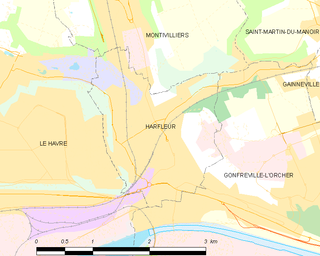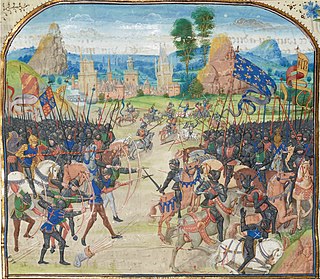
The siege of Harfleur was conducted by the English army of King Henry V in Normandy, France, during the Hundred Years' War. The defenders of Harfleur surrendered to the English on terms and were treated as prisoners of war. It was the first time that an English army made significant use of gunpowder artillery in the siege of a large urban settlement.

The siege of Rouen was a major event in the Hundred Years' War, in which English forces loyal to Henry V captured Rouen, the capital of Normandy, from the Norman French.

The siege of Calais occurred at the conclusion of the Crécy campaign, when an English army under the command of King Edward III of England successfully besieged the French town of Calais during the Edwardian phase of the Hundred Years' War.

The Battle of Blanchetaque was fought on 24 August 1346 between an English army under King Edward III and a French force commanded by Godemar du Fay. The battle was part of the Crécy campaign, which took place during the early stages of the Hundred Years' War. After landing in the Cotentin Peninsula on 12 July, the English army had burnt a path of destruction through some of the richest lands in France to within 20 miles (32 km) of Paris, sacking a number of towns on the way. The English then marched north, hoping to link up with an allied Flemish army which had invaded from Flanders. They were outmanoeuvred by the French king, Philip VI, who garrisoned all of the bridges and fords over the River Somme and followed the English with his own field army. The area had previously been stripped of food stocks by the French, and the English were essentially trapped.
The Battle of Auberoche was fought on 21 October 1345 during the Gascon campaign of 1345 between an Anglo-Gascon force of 1,200 men under Henry, Earl of Derby, and a French army of 7,000 commanded by Louis of Poitiers. It was fought at the village of Auberoche near Périgueux in northern Aquitaine. At the time, Gascony was a territory of the English Crown and the "English" army included a large proportion of native Gascons. The battle resulted in a heavy defeat for the French, who suffered very high casualties, with their leaders killed or captured.

The Battle of Caen was an assault conducted on 26 July 1346 by forces from the Kingdom of England, led by King Edward III, on the French-held town of Caen and Normandy as a part of the Hundred Years' War.

The town of Limoges had been under English control but in August 1370 it surrendered to the French, opening its gates to the Duke of Berry. The siege of Limoges was laid by the English army led by Edward the Black Prince in the second week in September. On 19 September, the town was taken by storm, followed by much destruction and the deaths of numerous civilians. The sack effectively ended the Limoges enamel industry, which had been famous across Europe, for around a century.

The Battle of Pontvallain, part of the Hundred Years' War, took place in the Sarthe region of north-west France on 4 December 1370, when a French army under Bertrand du Guesclin heavily defeated an English force which had broken away from an army commanded by Sir Robert Knolles. The French numbered 5,200 men, and the English force was approximately the same size.
The Battle of Valmont is the name given to two connected actions which took place between 9 and 11 March 1416 in the area of the towns of Valmont and Harfleur in Normandy. A raiding force under Thomas Beaufort, Earl of Dorset, was confronted by a larger French army under Bernard VII, Count of Armagnac at Valmont. The initial action went against the English, who lost their horses and baggage. They managed to rally and withdraw in good order to Harfleur, only to find the French had cut them off. A second action now took place, during which the French army was defeated with the aid of a sally from the English garrison of Harfleur.

The Gascon campaign of 1345 was conducted by Henry, Earl of Derby, as part of the Hundred Years' War. The whirlwind campaign took place between August and November 1345 in Gascony, an English-controlled territory in south-west France. Derby, commanding an Anglo-Gascon force, oversaw the first successful English land campaign of the war. He twice defeated large French armies in battle, taking many noble and knightly prisoners. They were ransomed by their captors, greatly enriching Derby and his soldiers in the process. Following this campaign, morale and prestige swung England's way in the border region between English-occupied Gascony and French-ruled territory, providing an influx of taxes and recruits for the English armies. As a result, France's ability to raise tax money and troops from the region was much reduced.

The siege of Aiguillon, an episode in the Hundred Years' War, began on 1 April 1346 when a French army commanded by John, Duke of Normandy, laid siege to the Gascon town of Aiguillon. The town was defended by an Anglo-Gascon army under Ralph, Earl of Stafford.

Lancaster's chevauchée of 1346 was a series of offensives directed by Henry, Earl of Lancaster, in southwestern France during autumn 1346, as a part of the Hundred Years' War.

The Crécy campaign was a series of large-scale raids (chevauchées) conducted by the Kingdom of England throughout northern France in 1346 that devastated the French countryside on a wide front, culminating in the Battle of Crécy. The campaign was part of the Hundred Years' War.

The Black Prince's chevauchée of 1356 was a large-scale mounted raid by an Anglo-Gascon force under the command of Edward, the Black Prince, between 4 August and 2 October 1356 as a part of the Hundred Years' War. The war had broken out in 1337, but a truce and the ravages of the Black Death had restricted the extent of the fighting since 1347. In 1355 the French king, John II, determined to resume full-scale war. That autumn, while Edward III of England threatened northern France, his son, Edward of Woodstock, later known as the Black Prince, carried out a devastating mounted raid, or chevauchée: an Anglo-Gascon army marched from the English possession of Gascony 675 miles (1,086 km) to Narbonne and back. The French refused battle, despite suffering enormous economic damage.
Lancaster's chevauchée of 1356 in Normandy was an English offensive directed by Henry, Duke of Lancaster, in northern France during 1356, as a part of the Hundred Years' War. The offensive took the form of a large mounted raid – a chevauchée – and lasted from 22 June to 13 July. During its final week the English were pursued by a much larger French army under King John II that failed to force them to battle.
The sieges of Berwick were the Scottish capture of the town of Berwick-upon-Tweed on 6 November 1355 and their subsequent unsuccessful siege of Berwick Castle, and the English siege and recapture of the town in January 1356. In 1355 the Second War of Scottish Independence had been underway for over 22 years. After a period of quiescence the Scots, encouraged by the French who were fighting the English in the Hundred Years' War, assembled an army on the border. In September a truce was agreed and much of the English army left the border area to join King Edward III's campaign in France.
The siege of Guînes took place from May to July 1352 when a French army under Geoffrey de Charny unsuccessfully attempted to recapture the French castle at Guînes which had been seized by the English the previous January. The siege was part of the Hundred Years' War and took place during the uneasy and ill-kept truce of Calais.
The Treaty of Guînes was a draft settlement to end the Hundred Years' War, negotiated between England and France and signed at Guînes on 6 April 1354. The war had broken out in 1337 and was further aggravated in 1340 when the English king, Edward III, claimed the French throne. The war went badly for France: the French army was heavily defeated at the Battle of Crécy, and the French town of Calais was besieged and captured. With both sides exhausted, a truce was agreed that, despite being only fitfully observed, was repeatedly renewed.

The siege of Breteuil was the investment of the Norman town of Breteuil, held by partisans of Charles II, King of Navarre, by French forces. It lasted from April to about 20 August 1356. It was interrupted on 5 July when a small English army commanded by Henry, Earl of Lancaster relieved and resupplied it. The French king, John II, attempted to bring Lancaster to battle with the much larger French royal army, but Lancaster marched away and the attempt failed. John then renewed the siege of Breteuil.

English offensives in 1345–1347, during the Hundred Years' War, resulted in repeated defeats of the French, the loss or devastation of much French territory and the capture by the English of the port of Calais. The war had broken out in 1337 and flared up in 1340 when the king of England, Edward III, laid claim to the French crown and campaigned in northern France. There was then a lull in the major hostilities, although much small-scale fighting continued.














